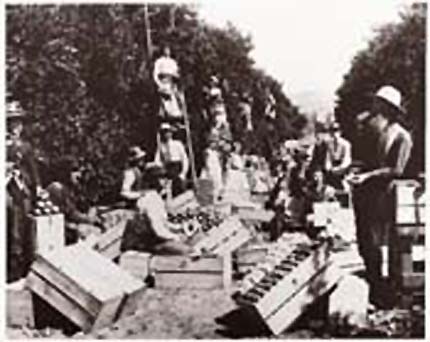|
THE
HISTORY

Packing
fruit in the groves, circa 1880
photo courtesy of oc.book.com
The
city of La Habra lies in a fertile valley between
the Puente Hills to the North and the Coyote Hills
to the south, in the farthest northwest corner
of Orange County. "La Habra," which in Spanish
means "pass through the hills," is one of the
oldest names in Orange County. It dates from the
days of Spanish exploration and the subsequent
mission period. The Portola' expedition crossed
through La Habra Valley on July 30, 1769, leaving
through the natural pass close to the present
Fullerton Road. During the mission period, La
Habra Valley and the surrounding hills were part
of the extensive lands belonging to the San Gabriel
Mission. They were used for grain and livestock
production.
In
1839 the Mexican government granted the 6,698-acre
Rancho Canada de la Habra to Mariano Reyes Roldan,
who continued to use the land for agriculture
and livestock. In the 1860's, this and many adjacent
ranchos became part of the vast holdings of Abel
Stearns, who used the land to graze his extensive
herds of cattle. However, disastrous seasons of
floods, freezes, and droughts in the mid-1860's
took a heavy toll of the herds, and Stearns was
forced to sell and lease much of his property.
In the early 1870's, the La Habra lands were leased
to Basque sheepherders. One of the Basques, Domingo
Bastanchury, later purchased much of the property
in the southern part of the valley and in the
Coyote Hills for a sheep ranch, and another Basque,
Jose Sansinena, purchased the foothills north
of La Habra for his ranch. During this period
thousands of sheep grazed all of the valley and
surrounding hills.
It
was not until the 1890's that many American, English,
and Swiss settlers arrived in La Habra. They planted
walnuts and deciduous fruit trees on acreage purchased
from the Stearns Ranchos Company.
The
"father" of La Habra city is considered to be
Willets J. Hole. As the land agent for the Stearns
Ranchos Company, he promoted sales of the La Habra
Lands near the center of the valley. One the south-facing
slopes near the present Citrus Drive, Hole established
a model 100-acre ranch, planted with many varieties
of citrus and deciduous trees. Hole also set up
a water pumping station near Coyote Creek to irrigate
his groves, showing how water could make the rich
soil produce abundant crops. Surface waters were
limited to the seasonal flow in Coyote and La
Mirada creeks.
The
year 1896 is commonly chosen to be the founding
date of the La Habra community. In that year the
post office, a store, and the grammar school were
started in the village, largely through the efforts
of W.J. Hole.
In 1903 Robert Hiatt bought property near the
village center and sold town lots. The streets
were named by the women of the Ladies Mutual improvement
Club, but many of the original names have been
changed through the years.
Water
had always been a problem for farmers with irrigated
crops. In 1903, water was finally brought from
the Bassett area by the East Whittier Land and
Water Company through a cement gravity-flow pipeline.
Later, these earliest pipes were replaced with
redwood lines, and pumping stations were established.
With the assurance of a reliable water supply,
much citrus acreage was planted in the upper valley
and on the south-facing slopes. This area had
a near perfect climate and soil for citrus production,
and La Habra fruit became well known.
In
1908 the Pacific Electric Railroad was brought
to La Habra to meet demands for hauling the citrus
fruit as well as the walnuts growing in the southern
part of the valley. The railroad was also used
to haul equipment to the newly-developed oil lands
in this area.
In
1913-14 the large Sunkist packing houses were
built. At one time, La Habra Citrus Association
controlled more citrus acreage that any other
in the state. During the period 1914-19, many
new oil workers came to La Habra for employment
in the highly productive Murphy-Coyotes oil lease
of the Standard Oil Company (now Chevron). At
the same time, several new business blocks were
built in downtown La Habra. Home-building was
also brisk. In 1916, the Sunkist Citrus association
erected housing in the southwestern part of La
Habra for the newly-arriving Mexican agricultural
workers.
The
foothills north of La Habra proved to be an ideal
growing area for avocados in the years since the
first commercial grove in Orange County was planted
on North Cypress Street in 1910. La Habra Heights
became the center for avocado production as a
result of promotion by land developer Edwin G
Hart. The original "Hass" avocado tree in La Habra
Heights was planted 1926, and survived until 2002.
This variety has become the most popular summer
avocado in the world.
The
1920's were boom years in La Habra. The First
Bank of La Habra was chartered in 1920. The city
of La Habra was incorporated January 20, 1925.
There was much expansion in the downtown area
along Central Avenue (now La Habra Boulevard)
in response to the needs of the growing population.
However, the economic depression of the 1930's
hit La Habra hard. Among the businesses of this
period in downtown La Habra was former President
Richard Nixon's first law office, established
in 1939. There was not much other building until
the late 1940's, after World War II. Large businesses,
such as the Alpha Beta Company and Beckman Instruments,
moved into the valley in the 1950's. Chevron Research,
part of a company that first came to the valley
in 1912, continued to expand its operations with
La Habra as its research headquarters until it
closed in 1999.
La Habra has maintained its prosperity in recent
decades. In 1975, it was honored by being named
an "All American City" in recognition of its many
community improvement programs for youth, seniors,
and minorities. The La Habra Depot Theatre is
the transplanted Pacific Electric Depot. Between
these two important buildings is the Children's
History Caboose, an old-time railroad car which
displays many historical artifacts from La Habra's
past. These exhibits are provided by the La Habra
Old Settlers' Historical Society, which has been
active since 1898, only two years after the community's
founding.
From
'A HUNDRED YEARS OF YESTERDAYS'
by Esther Ridgway Cramer
Contributed by the La Habra Area Chamber of Commerce
La
Habra Historical Sites:
La
Habra's Birthplace - Southeast corner of Euclid
Street and La Habra Boulevard
This is the original site of the town of La Habra's
store and post office. La Habra was founded in
1896. The site now is that of a statue, which
contains the bell of the first Catholic church
in the area.
La
Habra Pacific Electric Depot - 301 S. Euclid
St
The site is that of the earliest railroad line
in the La Habra area. The depot was moved from
its original site across the street to complement
a museum. The depot has been refurbished and now
is used as a community theater.
|


![]()

